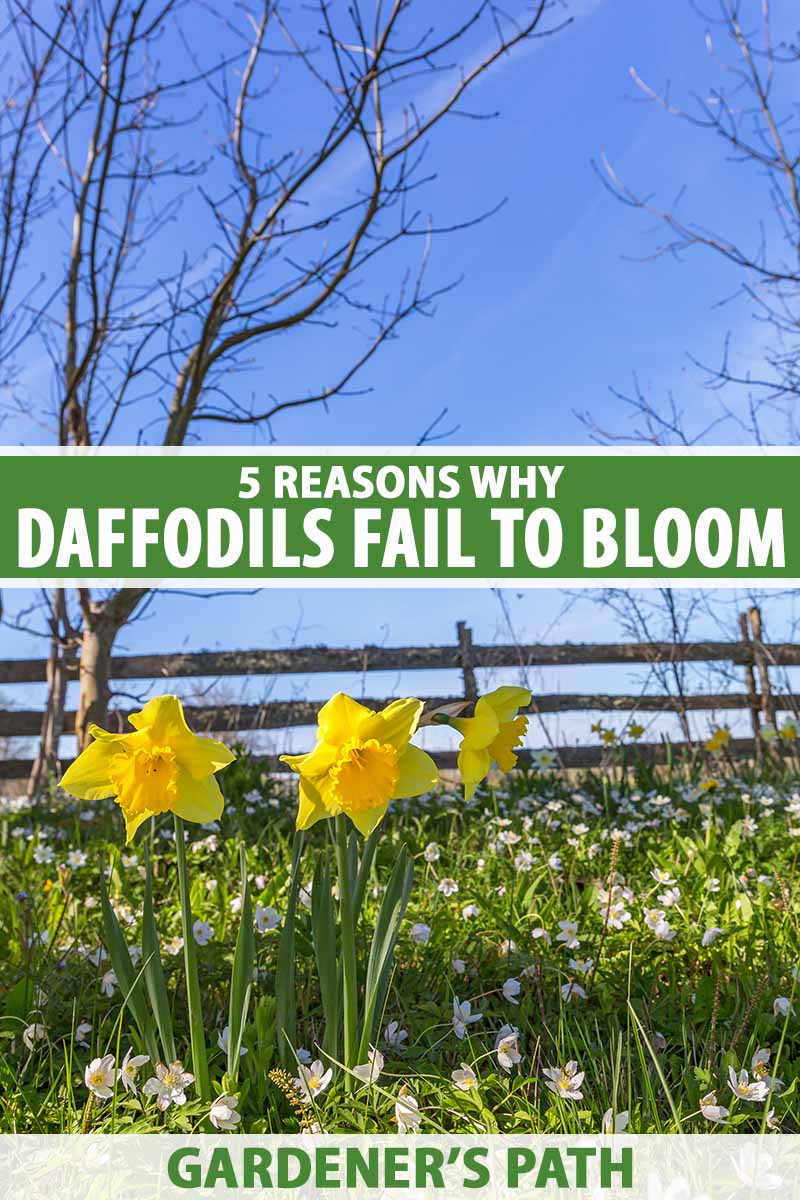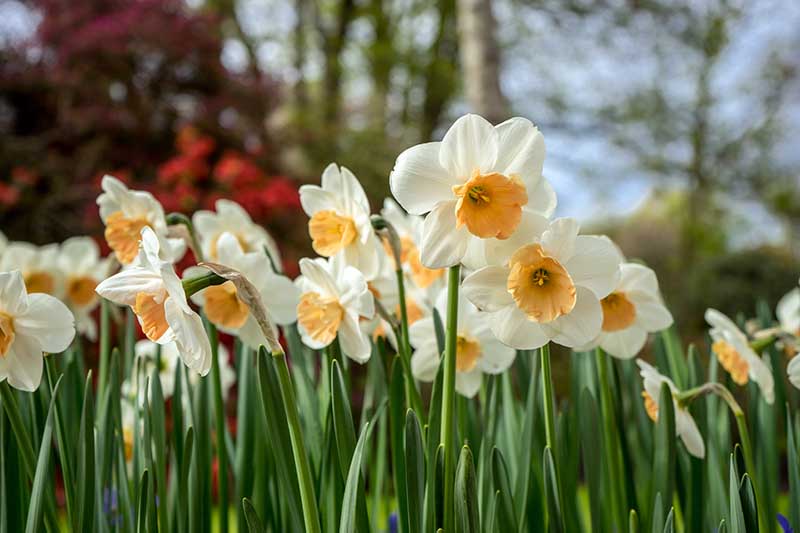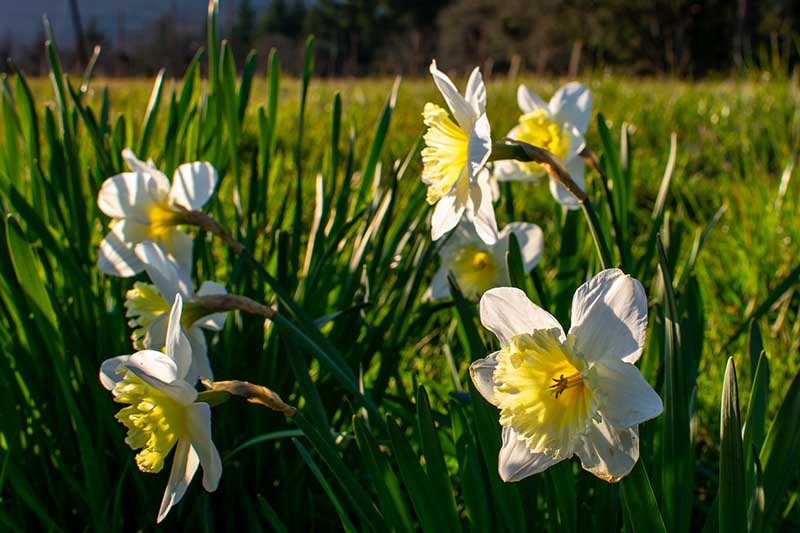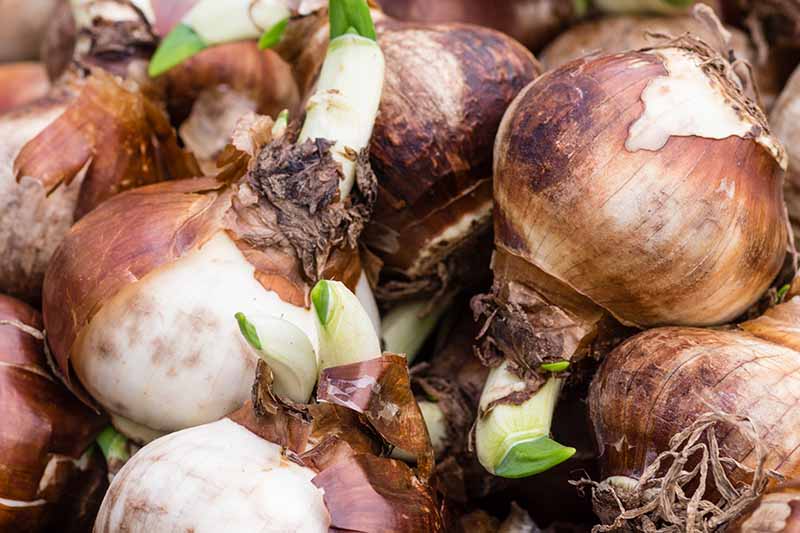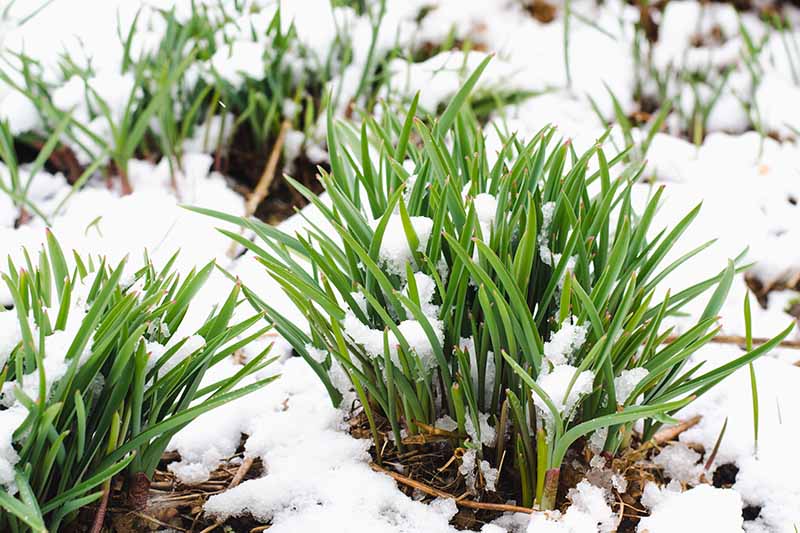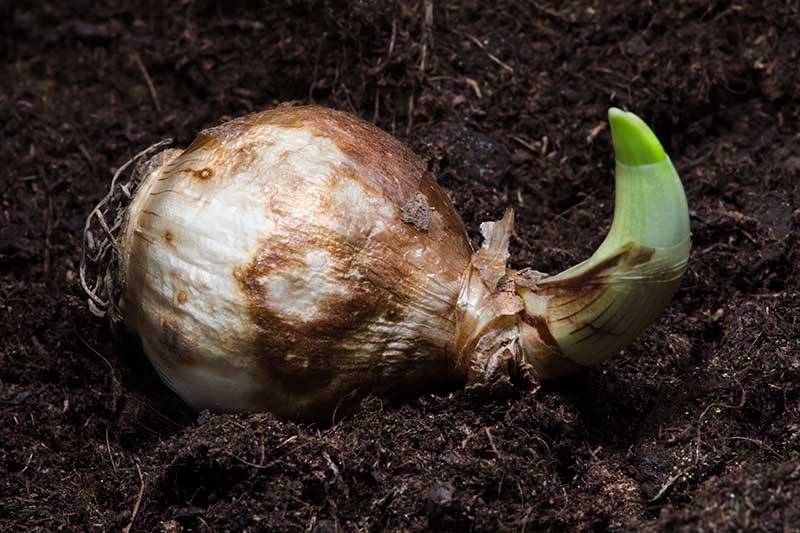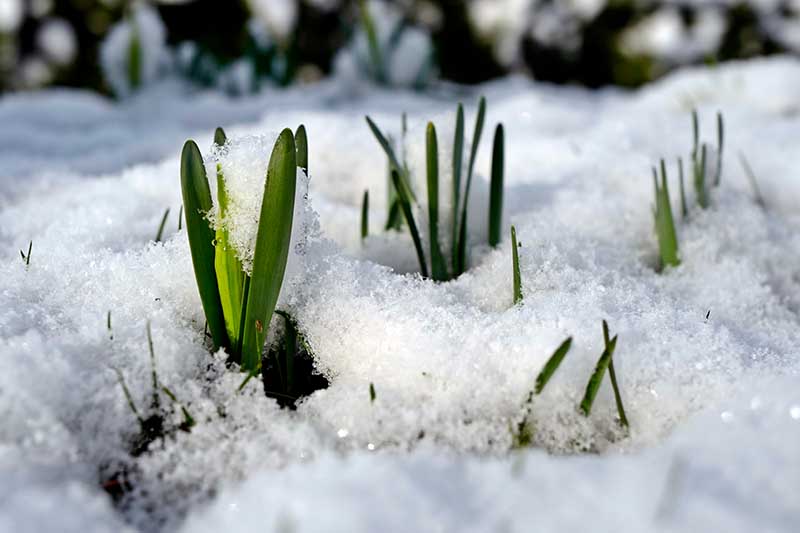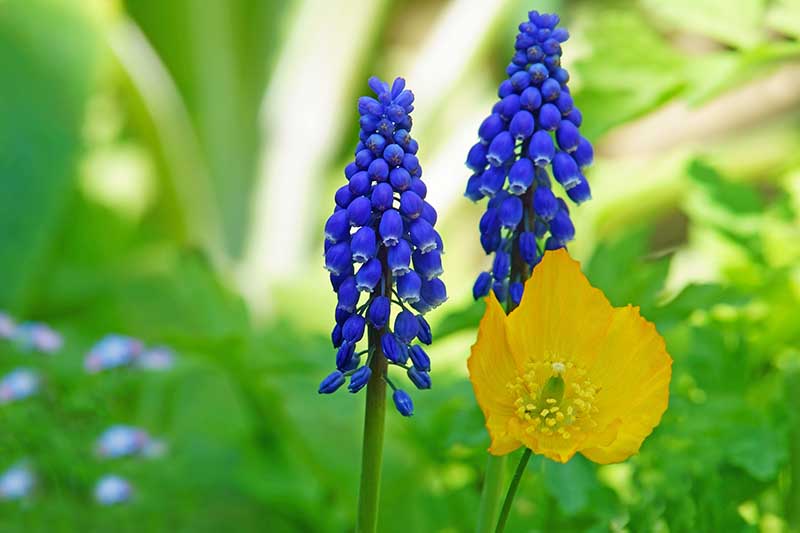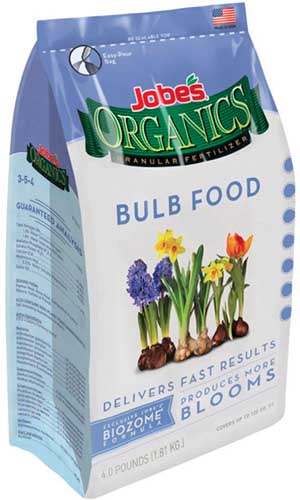You plant them before the ground freezes in the fall or winter, and then you’re rewarded in the spring with the most cheerful, nodding faces. Unless… you aren’t. Perennial daffodils (Narcissus spp.) are some of the first blooms of the spring season, opening their buds as early as January or February in warmer climes, and as late as April or May in frigid areas like Alaska, where I live. We link to vendors to help you find relevant products. If you buy from one of our links, we may earn a commission. Or what if the first leaves never even poke out of the ground? What’s gone wrong? Can you save your daffodils? Or is there at least something you can do for next time? In this guide, we’ll tell all. Here’s what I’ll cover:
Getting to Know Daffodils
Daffodils are members of the genus Narcissus, which is part of the subfamily Amaryllidoideae of the Amaryllidaceae family.I dare you to say that sentence five times in a row, fast. Other plants in this long-beloved subfamily include snowdrops and Belladonna lilies. And I’m sure you’re acquainted with other members of the overarching family, Amaryllidaceae: onions , garlic, and alliums (subfamily Allioideae), as well as agapanthus (subfamily Agapanthoideae). In short, the daffodil – also called “narcissus” or “jonquil,” especially in old English literature – is in good company. You can learn more about how to grow these yellow, white, orange, and even pink flowers in our growing guide. We gardeners almost always grow them from bulbs, since in order to grow them from seed you must manually pollinate them and then wait five to seven years for the seeds to develop into flowers. Besides, they propagate easily underground: the bulbs divide and grow new offshoots over the course of a few years, resulting in pleasing clumps of blooms clustering around the original flower. If they remain happy and well-fed, daffodils can live for years and years. When I bought my first house in Oklahoma, I got a pleasant surprise in spring: a large clump of daffodils that had been growing and reproducing for who knows how long. Daffodils truly are a gift that keeps on giving. And even though sometimes your blooms might not open, there’s almost always something you can do to help your jonquils survive into the next year. But in the event that all hope is lost for this season’s bulbs, you’ll at least know how to prevent the problem from happening again next time. Without further ado, here are the top five reasons why your daffodils aren’t flowering.
1. Bulbs Were Planted Too Late
So you’ve been staring expectantly at the ground for months, unease growing in your belly as your friends happily report that their first-year daffodil bulbs have bloomed. Yours, on the other hand, have not. Could it have to do with chill time, or lack thereof? Like many spring-flowering bulbs, daffodils need weeks upon weeks of chill time in order to bloom. When it comes to bulbs, “chill time” refers to any temperature between 35 and 45°F. And in order to properly bloom, daffodils need 13 to 15 weeks of chill time. If they don’t get it, they might not grow at all, much less provide you with pretty flowers. If you planted your bulbs too late and they didn’t get enough chill time, here’s what you can do: First, carefully dig up a bulb or two. If you notice yellowish shoots at the tip of the bulb, leave it in its place and replace the soil – the daffodils are on their way and are just taking their time. But if the bulbs don’t have shoots, dig them up. Fill containers that are six inches in diameter and that have drainage holes with fresh potting mix. Place three to five bulbs inside each pot, on the top of the potting soil, so that the bulb tips are just below the rim of the pot. Add more potting soil around the bulbs, but don’t cover their tips. Water each container slowly until liquid drains out the bottom. Find a spot in your home that stays between 35 and 45°F at all times. It could be a cellar, a basement, or even a refrigerator. Things might get messy if you keep the containers in your main refrigerator, but if you have an extra one in your garage, that’ll do the trick. It’s also helpful if your containers have drainage dishes to collect excess water. If you do keep the containers in a refrigerator, fold a dish towel and place it over each container, leaving gaps on each side for air. Daffodils require darkness in order to chill properly. Remember, you’re trying to mimic the conditions underground. Once a week, water the soil around the bulbs in each container slowly and deeply until water runs out the bottom of the container. Keep the containers in that cool place for 13 to 15 weeks, unless you believe they have had some chill time before. Perhaps, for example, they got a nice cold snap for four weeks in the winter. You could then try chilling them for just nine to 10 weeks, or until you see yellow shoots begin to emerge from the tips of the bulbs. That’s your cue that they’ve done enough chilling and are ready for higher temperatures and more light. Bring the containers into an area with about four to six hours of indirect daylight and temperatures between 50 and 60°F until the shoots turn green. At this point, you can transplant the bulbs into the ground or put the containers outside in an area that receives full sunlight and stays between 60 to 70°F. Or, if it’s full-blown summer where you are, keep the flowers indoors in a bright windowsill and plant them into the garden in the fall!
2. Diseased or Damaged Bulbs
Were you so excited when you received your bulbs in the mail or brought them home from your grocery store’s gardening section that you planted them all without thinking about checking the health of each bulb first? I totally understand. But if your daffodils just aren’t growing, it might have something to do with the health of the bulbs when you received them. Or maybe they are growing, but the shoots:
Die shortly after emerging through the soilAre chlorotic (have yellowing foliage that becomes paler over time)Grow but don’t produce blossoms, or produce weak blossoms that shrivel and die prematurely along with the rest of the plant
If this is the case, you might be looking at something more serious, like basal rot, a deadly disease caused by the fungus Fusarium oxysporum var. narcissi. Dig up a few bulbs. If they’re soft, dark brown at the basal area where the roots emerge from, and white, pink, or reddish-purple when you peel back a few of the outer scales, you’re looking at a case of F. oxysporum var. narcissi. When you purchase or receive bulbs in the mail, it pays to carefully squeeze each one to check for softness. You do not want softness. If the bulbs give between your fingers or turn to mush, sadly you’ll need to toss them and hope for better luck next time. Most of the time, bulbs from reputable nurseries will be firm and healthy, whether you buy them in-store or online. Still, it’s a good idea to check them upon arrival. The nursery can do its utmost to package the bulbs well, but maladies like delayed shipping or postal snafus can cause the daffodils-to-be to suffer. When you get bulbs from the grocery store or big-box stores, they’re more likely to have spent a lot of time packed together in crates in stuffy warehouses. These conditions often result in the spread of basal rot. Unfortunately, basal rot can survive in the soil for years. Once infected bulbs have been planted in an area, it’s best to try again with healthy ones in a completely different part of your yard or garden that does not share the same soil. Or, plant them in containers and put them wherever you want – I wouldn’t plop them on top of the soil where your sickly bulbs infected the dirt, though.
3. Daffodils Planted in an Inhospitable Area
I can’t stress enough how important it is that you plant your daffodils in an area that receives adequate drainage and appropriate sunlight. Without these things, your bulbs can experience issues that prevent them from growing or blooming. Planting them in an area that consistently becomes soggy and waterlogged simply won’t work, as it greatly increases the likelihood that they’ll develop a fungal infection that leads to bulb rot. Sunshine is also important for blooming. Daffodils can be planted in semi-shady areas, but it’s imperative that they receive at least six hours of sunshine a day in order to bloom. Make no mistake: you can definitely plant your daffodils under trees – as long as the trees are deciduous. Most of the time, daffodils will bloom before the trees get all their leaves, allowing the plants to get adequate sunshine. Just don’t go planting your bulbs in muddy bogs, under evergreens, or in areas that receive less than six hours of sun. And if you accidentally do one of these things or something similar, carefully transplant them to a sunnier, friendlier area.
4. You Removed Last Year’s Foliage Too Soon
If you eagerly removed the daffodil foliage last year right after the final blossom shriveled, I don’t blame you for this either! A narcissus past its heyday doesn’t shout vim and vigor, but here’s a secret: for about six weeks after the last bloom fades, the foliage works hard, absorbing energy from the sun and channeling it into the bulb for next year’s flowers. Cutting this foliage before it begins to turn yellow and die back on its own prevents that crucial work from happening, resulting in a no-show the next year. It can also be tempting to tie or braid the leaves together to make them look a bit more appealing, but that can reduce the leaves’ efficiency at absorbing sunlight. So keep watering your daffodil foliage regularly even after the final blossom fades. Deadhead spent blooms to prevent seeding, since you want the plant to focus all its energy on preparing next year’s bounty. When it begins to turn yellow, you can stop watering and cut the leaves back or mow them if you desire. If you don’t like staring at shriveled daffodil leaves, plan your garden so that you’ve got new flowers blooming right as your daffodils are dying back: daylilies, grape hyacinths, irises, peonies, and poppies are all excellent choices. They’ll bridge the gap between the early blooms and your summer perennials.
5. Fertilizer Issues
Sometimes, bulbs won’t bloom if they haven’t been given an adequate amount of fertilizer. Or, they won’t bloom if they’ve had too much fertilizer, especially too much fertilizer that’s high in nitrogen. Here’s what you need to know about fertilizing daffodils: First, know that you don’t need to fertilize your bulbs in the first year if you don’t want to. Bulbs from a nursery contain all the energy and nutrients needed to produce flowers in its first year. Nitrogen is a necessary plant nutrient, but it promotes leafy growth. Lots and lots of leaves may be produced as a result of overfertilizing… and not very many flowers. You can add some to the planting site in the fall, or if you miss that particular deadline, you can top-dress with a 3-5-4 NPK fertilizer like this one from Jobe’s Organics, available from the Home Depot, as soon as the first leaves poke out of the soil. Jobe’s Organics Bulb Fertilizer When the flower buds begin to form, top dress again but with bone meal this time. I love this one from Dr. Earth, available at Home Depot, and use it on all my flowering bulbs just as they’re about to open those gorgeous blooms. Dr. Earth Bone Meal The phosphorus in the bone meal helps keep the flowers healthy. Whatever you do, don’t use a high-nitrogen fertilizer at any point, and stick with low-nitrogen products that have a lower number in the N position on fertilizer labels. For more information, consult our guide, “How and When to Fertilize Daffodils.” Have you ever had issues with daffodils not blooming? We’d love to hear your stories and questions in the comments section below. And for more information about growing daffodils in your garden, check out these articles next:
The Best Companion Plants for Daffodils15 of the Best Daffodil Cultivars for Naturalized Plantings
